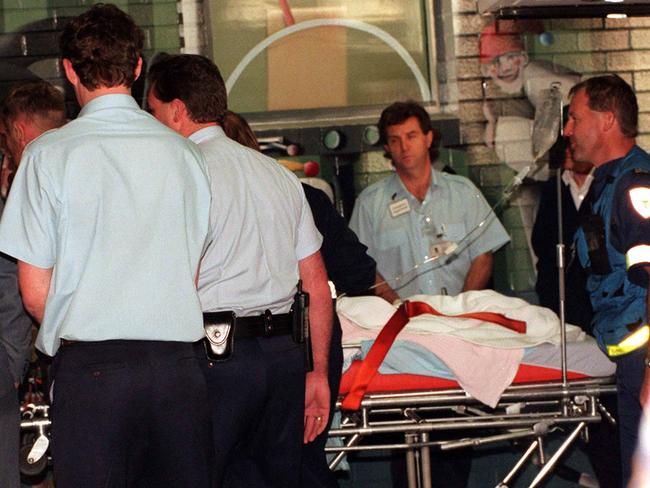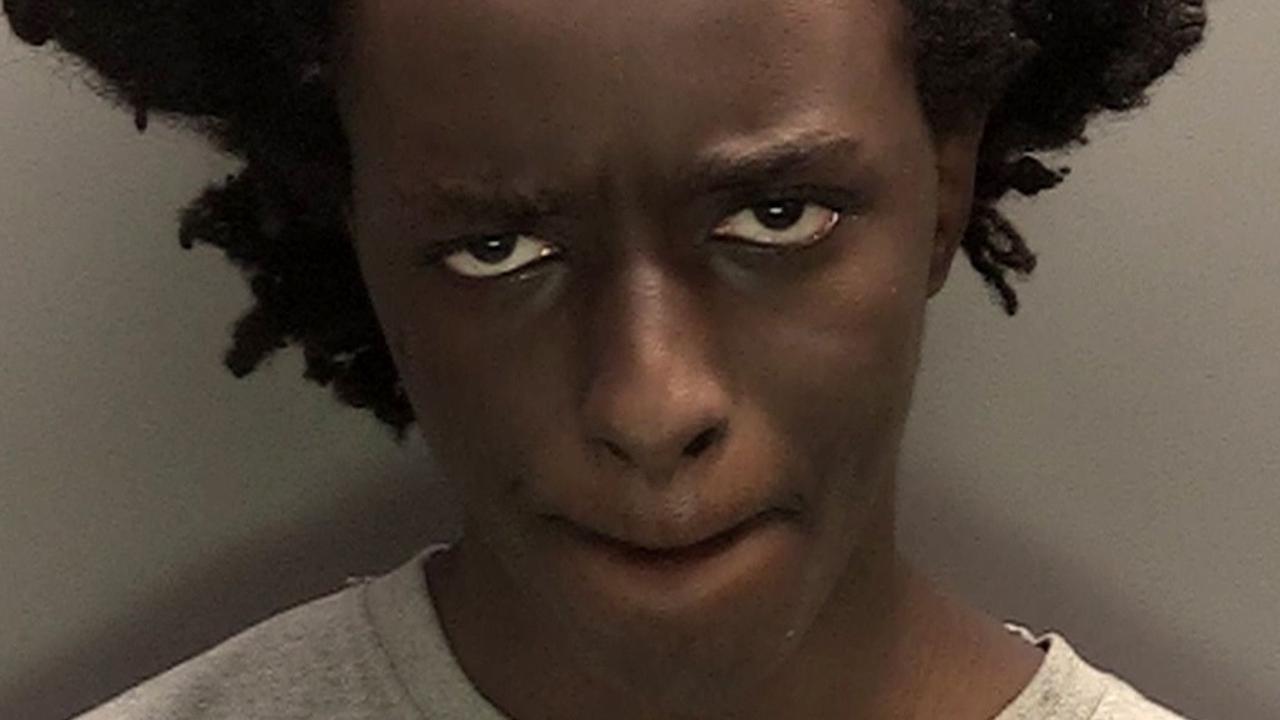Special ops cop relives horror of Port Arthur massacre
A Special Operations Group police officer has relived the horror of the Port Arthur massacre and how it changed him forever.

Crime in Focus
Don't miss out on the headlines from Crime in Focus. Followed categories will be added to My News.
Exclusive: For a long time after the Port Arthur massacre, Jim Morrison carried a gun everywhere he went.
The Special Operations Group (SOG) police officer felt a “moral obligation’’ to stop such a massacre happening again.
“I carried it 24/7. It was next to my bed. I went shopping, I carried it,’’ he recalled this week of his police-issued firearm.
“I was trying to get control. I was never going to let that happen again whilst I was somewhere where I could change it.’’
Morrison has until now declined to speak publicly about his actions on the day of April 28, 1996, when a lone gunman massacred 35 people and wounded 20 more at the Port Arthur historic site in Tasmania.

But he has now agreed to detail his involvement when, as tactical commander of Tasmania Police’s Special Operations Group, he led the team which contained and eventually arrested the gunman, Hobart man Martin Bryant.
He remains deeply disturbed that the SOG was not able to prevent the massacre.
“It’s still one of my greatest frustrations to this day, such a highly-trained group and we were bolstered by Victorians (specialist police) coming across, but we didn’t get a chance to stop the carnage,’’ he said.
“It had all occurred before we were deployed. All the tragedy that occurred at the Broad Arrow Café and that whole historic site and at the Seascape property had all occurred before we were deployed there.
“It changed me forever.
“Our role is to eliminate threats and we do that quite effectively. But not on this day.’’
Tasmania Police’s Special Operations Group is a part-time unit. Morrison, then 38, was the 2IC and the tactical commander, and his day job was as a detective senior-sergeant working the crime beat in Hobart.
He was at home on his bush block outside Hobart on that autumn afternoon when a colleague rang to alert him there were reports of a shooting at Port Arthur, and police were responding.
“The first call intimated there were maybe four or five people who had been shot,’’ he said.
“Soon after that the calls came thick and fast. It went from five (casualties) to six to eight to 10 to 12 to 16 people had been shot.’’
Morrison assembled the SOG duty team and sent them to the forward command post a few kilometres from the Port Arthur convict site.

Knowing how remote and heavily-forested the area was, he managed to get a helicopter to take him down for a visual survey, and knew immediately from what he was hearing through the headset that a tragedy was unfolding.
“The radio chatter, the amount of noise and messages during the very early stages of this catastrophic event. It was quite apparent, you just heard, you knew by the tone of their voices and the reports that were coming, this was going to be a terrible day,’’ he said.
“It was a terrible day and it was going to get worse. People had been injured, terribly so.’’
A plume of smoke was seen at the nearby Seascape guesthouse, which correlated with a report a car had been hijacked at a local service station and taken to Seascape and set on fire.
The police didn’t know it then, but Bryant, armed with several high-powered rifles, had bunkered down for a siege, setting up piles of ammunition at the windows of the guesthouse, and firing hundreds of rounds throughout the day, and into the next night.
Morrison had to form a plan. There were two police pinned down in a ditch outside Seascape, unable to move due to gunfire. There were three known hostages at Seascape. People from the properties nearby needed to be evacuated.
There were an unknown number of people killed and injured down the road at the historic site. And there were an unknown number of offenders on the loose.
Tasmania’s SOG might have been a part-time group but they were required to maintain national counter-terrorism standards, and Morrison had made good contacts over the years with the Army.
They got access to some Specialist Air Services (SAS) 4WD vehicles. They also inquired as to whether the Army had any armoured personnel carriers in Tasmania, to help evacuate the injured. They didn’t. Morrison made another plan and called in a D9 bulldozer. Police would use its blade for cover and approach the property, if required. Under an emergency action plan such as this, they estimated up to 30 per cent of their team would suffer casualties.

The SOG stayed just out of line of sight of the guesthouse, while a marksman observer kept eyes on the property. No-one came in or out that night. The two police trapped in the ditch were rescued after darkness fell, dragged out by SOG members.
Then day broke on Monday, April 29, and smoke began pouring from the guesthouse.
“We hadn’t bargained for this, we hadn’t bargained for the house catching fire. The flames were pouring out of the windows. Straight away our emergency action plan had to be revised,’’ Morrison recalled.
The team got the codeword they’d been waiting for and raced to the scene, Morrison and his colleagues from Victoria and Tasmania on the back of the SAS vehicles.
“A naked person had been seen lying on the ground near one of the back corner of the property,’’ Morrison said.
“He was cuffed. We detained the guy. He was burnt.
“It became apparent there weren’t any other people outside the building and there weren’t any other cries or sounds coming from inside the property. All hostages were (later) found dead inside the charred remains of the building.’’

Later, police would face some criticism over the fact they hadn’t shot Bryant dead.
Morrison said it was the right decision not to use lethal force.
“During that siege we had no justification to shoot him at any stage. Or shoot anyone for that matter. There was no executive order. There was no legal reason for anyone of our team for that matter for the whole duration of that to shoot at anyone,’’ he said.
Bryant was taken away in an ambulance. Morrison never spoke a word to him.
“I don’t even want to say his name. I don’t want to give him any more minutes on this earth of notoriety for what he did. He doesn’t deserve anything. For me he’s just another offender that committed some atrocious acts and I hope he rots in hell.’’
Morrison was born in Sale, Victoria, and moved to Tasmania with his mother after his father, a returned soldier, died in a road accident when his son was just five years old.
“I always wanted to be a Victorian cop. Since I was four I wanted to be a policeman. I went back and joined Tasmania Police straight after school. Made it a career. I thought. Until I left,’’ he said.
A charismatic high-achiever, he was being groomed as a future commissioner, when he shocked Tasmania Police by resigning in 2001 to pursue a career in the private sector.

He worked a few jobs, including as a motion picture armourer on the Tom Hanks production The Pacific, where he trained actor Rami Malik, among others, how to handle weapons.
Now aged 63 and living in Melbourne, he works mainly in the oil and gas industry advising on crisis management and business continuity.
Morrison said while he had left Tasmania, he had not turned his back on it after the massacre.
“For another five years I lived and breathed it with the Tasmanian community and saw their grief and still see it. It’s sensitive to this day and it is for me as well.’’
He said he had decided to speak because 25 years had passed, and his words may help others.
“We’ve got to make sure we don’t have a gun culture like America and we have got to make sure another Port Arthur never happens.’’





